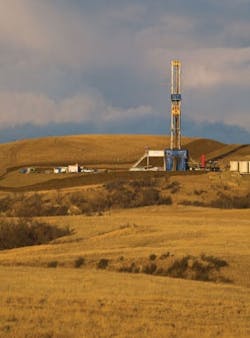A growing number of independents plans to accelerate development of crude oil and liquids-rich plays, driven largely by horizontal drilling results in the Eagle Ford shale of South Texas and by growing production in North Dakota's Bakken formation.
Carrizo Oil & Gas Inc. and Goodrich Petroleum Corp. each announced plans to acquire bigger stakes in the Eagle Ford, while EOG Resources Inc. reaffirmed its commitment to oil shale, citing discoveries in Texas, North Dakota, and Colorado.
Mark G. Papa, EOG chairman and chief executive officer, told analysts Apr. 7 that he believes horizontal oil wells in unconventional rock will prove to be "a North American game changer."
EOG Resources Inc. executives say they are rapidly advancing horizontal technologies to boost recovery rates from US oil plays. EOG recently increased its estimated recovery potential from its Bakken acreage. Photo from EOG.
He expects Eagle Ford discoveries could be among the largest US oil discoveries in 40 years. The play also produces gas, natural gas liquids, and condensate.
Oil development from shale plays is an outgrowth of the shale gas revolution, Papa said. He sees US independents as having three choices in their "big oil" quest: horizontal oil onshore in unconventional plays, Canadian heavy oil, or deep water.
Papa believes oil shale poses the least exploration risk and offers the best return on investment. In addition to ongoing development of oil shale, EOG is evaluating additional oil shale opportunities.
EOG expects its production growth will be driven primarily by increases in crude oil, condensate, and NGLs. For 4 years, EOG has worked quietly to accumulate lease positions in crude oil and liquids-rich plays amendable to horizontal drilling, Papa said.
Eagle Ford's potential
The Eagle Ford oil play has a history of production via vertical wells, although the area has experienced little exploration for many years, enabling EOG to acquire lease holdings. Some Eagle Ford vertical wells have produced for 30 years, EOG notes.
Robert K. Garrison, EOG vice-president of exploration, said EOG used existing information from 12 vertical oil production wells as a model to design its delineation wells. Within the oil window of the Eagle Ford play, EOG drilled 16 delineation wells over a 120-mile trend. These wells produced in the range of 218-1,658 b/d.
Some believe Eagle Ford could be the source rock for much of the Austin chalk, Garrison said. EOG exploration and early drilling results indicate most of Eagle Ford's oil remains in the source rock, he added.
EOG believes Eagle Ford is a very large source rock, having a high-carbonate content reservoir with excellent porosity, permeability, and oil storage opportunities.
Papa estimates EOG's Eagle Ford recovery potential at 900 MMboe of crude oil, net after royalty, based on initial drilling and production results on a 505,000 net-acre position. The company notes that it's too early for official reserve estimates that would be recognized by the US Securities & Exchange Commission.
Executives forecast EOG's Eagle Ford production at 6,000 boed during 2010, and they expect to increase it to 185,000 boed by 2016.
Meanwhile, El Paso Corp. added a second rig to its Eagle Ford drilling program after reporting that its Hixon-1H well in La Salle County, Tex., averaged 2.9 MMcfd of gas and 721 b/d of 51.7° gravity condensate after a 14-stage frac in a 4,100-ft lateral.
The flow at the company's second Eagle Ford well came on a 24⁄64-in. choke with 1,822 psi flowing casing pressure. The gas measured 1,368 btu/scf. True vertical depth was 9,950 ft. El Paso holds a combined 138,000 net acres in three areas of the Eagle Ford.
Smaller companies involved
Smaller companies are following bigger independents in the move to boost crude oil and liquids production and reserves. By first-quarter 2011, Carrizo Oil & Gas hopes to increase its crude oil and liquids production levels.
Marathon Oil Corp. holds 336,000 net acres in the Bakken oil play in North Dakota and eastern Montana. Marathon has four rigs drilling the Williston basin, and the company anticipates drilling 61 wells during 2010 and 264 wells gross over 5 years. Photo from Marathon.
Carrizo plans a pubic offering to finance drilling two horizontal wells in Eagle Ford shale, principally in La Salle County. In addition, Carrizo is pursuing land acquisitions in an unconventional oil play in the Niobrara formation in Colorado's Denver-Julesberg basin where it wants to drill horizontal wells.
The targeted acreage acquisition for Carrizo is near where EOG recently announced discoveries. EOG has built a position of 400,000 net acres in the Cretaceous Niobrara fractured shale (OGJ, Apr. 12, 2010, Newsletter).
EOG currently is running two rigs in the Niobrara, where it plans to drill several exploratory wells this year. The EOG Jake 2-01H in Weld County, Colo., produced 50,000 bbl of oil in its first 90 days on production during third-quarter 2009.
Elsewhere, Goodrich Petroleum is acquiring 70% interest in leases covering 50,000 gross (35,000 net) acres within the Eagle Ford oil window in the Texas counties of La Salle and Frio. As of Apr. 14, Goodrich declined to elaborate on its partners on these leases pending closing of the transaction.
Goodrich plans to maintain its 2010 capital expenditure budge of $255 million although it's reallocating $50 million of its budget to the Eagle Ford shale oil play.
Rosetta Resources Inc. of Houston reports it reached total depth on seven Eagle Ford wells. It had only added two of these wells to production and the other drilled wells were pending completion earlier this year.
The gross 7-day rate on the two completed and producing wells averaged 3.2 MMcfd of gas, 350 bbl of condensate, and 490 bbl of NGLs for a total of more than 8.2 MMcfd equivalent per well.
About 80% of the value of these recently completed wells consists of liquids, said Randy Limbacher, Rosetta's chairman, chief executive officer, and president.
The lateral length of the seven drilled wells averaged 4,650 ft, roughly a 20% increase compared with Rosetta's two 2009 horizontal wells. Three of the seven drilled wells were fracture-stimulated during first quarter with 12-14 frac stages/well.
Rosetta reported that first-quarter 2010 exit rate for its four producing Eagle Ford wells was more than 13 MMcfd, also exceeding expectations.
Bakken rig count grows
Numerous oil companies said during April that they eagerly awaited the return of weather favorable to drilling in the Bakken formation of the Williston basin in North Dakota. Advances in horizontal drilling techniques and multiple-stage fracturing have made the Bakken a more productive oil play, Ron Ness, president of the North Dakota Petroleum Council, told OGJ.
Brigham Exploration Co., Austin, recently proposed a public stock offering to raise money to accelerate its development drilling program on its core 161,900 net acres in the Bakken and Three Forks areas.
Bud Brigham, Brigham chairman, president, and chief executive officer, said 18 long lateral high-frac stage wells have averaged 2,581 boe during early peak 24-hr flow back periods.
Assuming a successful public offering, Brigham anticipates increasing its operated rigs in the Williston basin to eight from four by May 2011. The anticipated updated budget would enable Brigham to finance 31 net horizontal Bakken and Three Forks wells this year, focusing on Rough Rider and Ross project areas in Williams, McKenzie, and Mountrail counties of North Dakota.
During 2011, Brigham currently anticipates drilling 44-45 net Bakken and Three Forks wells in the same areas.
Ness said he is seeing interest grow in the Bakken, where the overall rig count in western North Dakota reached 106 rigs by Apr. 9. Ness expects that the rig count will surge past 125 this year.
"The typical well here is 2 miles down and 2 miles out," Ness said, adding that some operators have reduced drilling times for a Bakken well to 20-30 days. The Bakken underlies more than 200,000 sq miles in North Dakota, Montana, and Saskatchewan.
Pritchard Capital analysts said Nabors Industries Inc. is getting much of the drilling jobs for horizontal oil drilling in the Bakken.
"Contracting 33% of all rigs in the Bakken, more than tripling its closest peer [Cyclone Drilling], Nabors appears well positioned to expand its operated fleet in the basin, which has limited supply available and has consistently commanded the highest rates on term contracts of the major US land plays," Pritchard Capital analysts said.
More Oil & Gas Journal Current Issue Articles
More Oil & Gas Journal Archives Issue Articles
View Oil and Gas Articles on PennEnergy.com



